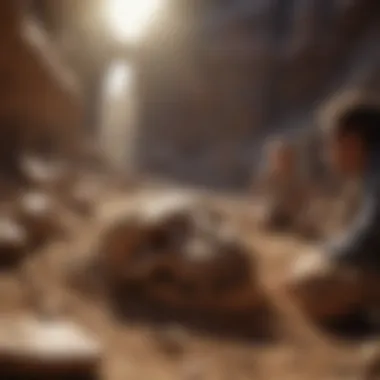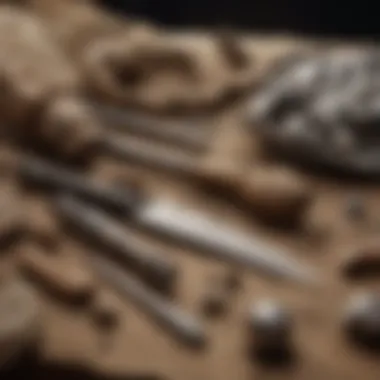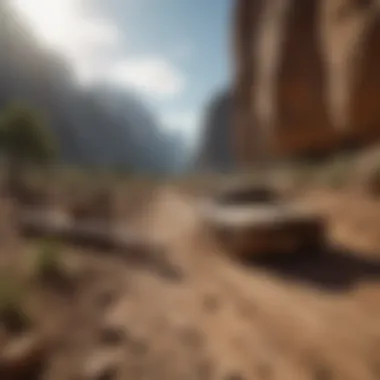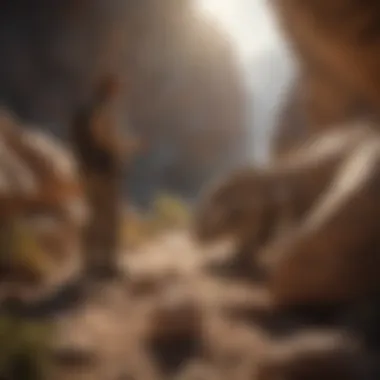Uncover the Enigma: Where to Explore for Dinosaur Fossils


Rock and Fossil Identification
In the captivating realm of dinosaur fossil excavation, discerning between various types of rocks and fossils is paramount. Recognizing distinct characteristics is key to successful identification. When embarking on a dig for dinosaur bones, pay close attention to the textures, colors, and structures of rocks and fossils. Understanding these key features will aid in distinguishing between different types accurately. Utilizing specialized tools, such as magnifying lenses and geologist hammers, can further enhance the identification process.
Collecting Tips and Techniques
Aspiring fossil collectors must adhere to best practices when it comes to collecting dinosaur bones. Locating prime sites for excavation involves thorough research and knowledge of geology. Investigate regions with sedimentary rock formations, as they are likely to harbor fossils. Prior to extraction, ensure you have the necessary permits and follow strict guidelines to avoid damaging the specimens or compromising scientific integrity. Employing delicate tools like brushes and chisels can aid in safely extracting fossils from the surrounding rock without causing any harm.
Preservation and Display
Preserving and displaying dinosaur bones require precision and careful handling. Techniques such as casting replicas and using archival materials are essential for long-term preservation. Proper storage methods involve maintaining stable environmental conditions to prevent deterioration. For creative display ideas, consider showcasing fossils in a visually appealing manner that educates and intrigues viewers, such as setting up themed exhibits or interactive displays.
Geological Insights
Delve into the geological aspects of dinosaur fossil excavation to uncover unique insights. Understand the formations and processes that led to the preservation of these ancient remains. Explore the historical significance of key rocks and fossils, shedding light on Earth's evolutionary history. Learn about notable discoveries in the field, uncovering groundbreaking findings that have shaped our understanding of prehistoric life.
Exploring the World of Dinosaur Fossils
Embark on a fascinating journey into the realm of dinosaur fossils, where ancient secrets lie waiting to be unearthed. In this article, we will delve into the significance and multiple benefits of exploring the world of dinosaur fossils. Understanding these prehistoric remnants not only offers insights into the past but also contributes significantly to our knowledge of evolutionary history and scientific advancements. This exploration opens a gateway to a myriad of discoveries that shape our understanding of ancient life forms and their existence.
Introduction to Dinosaur Fossils
Diving into the realm of dinosaur fossils, we encounter a profound aspect – Understanding the Significance of Dinosaur Fossils. This pivotal element not only sheds light on the importance of these fossils in unravelling the mysteries of the past but also provides crucial data for scientific research. Exploring Evolutionary Insights from Dinosaur Discoveries further enriches our understanding of the biodiversity and evolutionary processes that have shaped our world. This section aspires to convey the critical role these discoveries play in expanding our knowledge base and evolving scientific narratives.
Types of Dinosaur Fossils
Bones and Skeletons
When we consider Bones and Skeletons in the context of dinosaur fossils, we are drawn into a world where physical remnants serve as windows to an ancient era. These well-preserved skeletal structures provide valuable information regarding dinosaur anatomy, behavior, and evolution. Their study enables paleontologists to recreate the past and gain deeper insights into the creature's morphology.
Footprints and Trace Fossils
Footprints and Trace Fossils offer a unique perspective on dinosaur existence, allowing us to trace their movement patterns, group behavior, and ecosystem interactions. These impressions in sedimentary layers unveil a dynamic narrative of prehistoric times, offering glimpses into the daily lives of dinosaurs and their impact on the environment.


Eggs and Nests
Eggs and Nests present a delicate yet crucial aspect of dinosaur fossilization. These reproductive remnants not only showcase the reproductive strategies of ancient reptiles but also provide insights into nesting behaviors and parental care. The study of eggs and nests expands our understanding of dinosaur life cycles and evolutionary adaptations.
Importance of Preserving Dinosaur Fossils
Exploring the importance of preserving dinosaur fossils unveils a myriad of scientific and educational opportunities. Scientific Research Applications harness the data gathered from these fossils to conduct in-depth analyses, formulate hypotheses, and contribute to various scientific disciplines. Meanwhile, Educational Significance underscores the role of fossils in educational settings, serving as tangible tools for teaching evolution, biodiversity, and paleontological principles.
Scientific Research Applications
Scientific Research Applications leverage the diverse range of data extracted from dinosaur fossils to delve into evolutionary patterns, ecological interactions, and biological adaptations. The integration of fossil evidence in scientific research allows for a holistic understanding of Earth's past inhabitants and their evolutionary trajectories.
Educational Significance
The Educational Significance of dinosaur fossils lies in their ability to captivate students and impassion them about the natural world's history. By incorporating fossils into educational curricula, educators can engage learners in hands-on experiences, fostering a deep appreciation for paleontological principles and scientific inquiry.
Top Locations for Dinosaur Bone Excavation
When unveiling the mystery of where to dig for dinosaur bones, exploring the top locations worldwide becomes paramount. These locations showcase significant history and geological formations that make them hotspots for paleontologists, researchers, and enthusiasts alike. Understanding the importance of finding the right locations can greatly impact the success of dinosaur fossil excavation endeavors, offering valuable insights into prehistoric life. The top locations highlighted in this article provide unique opportunities and challenges, each contributing to the overall tapestry of dinosaur fossil discovery and research.
North America
Montana's Hell Creek Formation
Montana's Hell Creek Formation stands out as one of the most renowned locations for dinosaur bone excavation. Its rich sedimentary layers dating back to the Late Cretaceous period hold a treasure trove of fossils, including those of the iconic Tyrannosaurus rex and Triceratops. The geographical features of Hell Creek Formation, such as its vast expanse and fossil diversity, make it an ideal choice for paleontologists aiming to uncover well-preserved dinosaur specimens. Despite its popularity, logistical challenges in excavation and preservation exist due to the fragile nature of the fossils within its strata. Proper techniques and care are essential to ensure the integrity of the delicate finds in this significant site.
Utah's Grand Staircase-Escalante National Monument
Utah's Grand Staircase-Escalante National Monument offers another intriguing landscape for dinosaur bone excavation. This area's geological formations encompass various Mesozoic eras, providing a glimpse into the evolution of extinct reptiles and ancient ecosystems. The rugged terrain and unique rock exposures make Grand Staircase a favored destination for researchers seeking new discoveries. However, the remote location and harsh climate pose challenges in terms of fieldwork logistics and fossil extraction. Despite these obstacles, the vast potential for remarkable finds drives paleontologists to navigate the complexities of excavating within this distinctive environment.
Wyoming's Morrison Formation
Wyoming's Morrison Formation boasts a geologically significant landscape for uncovering dinosaur bones. This formation preserves fossils from the Late Jurassic period, offering insights into the diverse species that roamed ancient Wyoming. The abundance of well-preserved skeletons and articulated remains in the Morrison Formation captivates scientific interest and fuels paleontological studies. The accessibility of certain areas within the formation eases the logistical aspects of fossil excavation, promoting scientific exploration and discovery. However, competing interests such as land use management and conservation efforts underscore the importance of responsible fossil collection and site preservation in this critical dinosaur fossil hotspot.


Techniques for Digging Dinosaur Bones
Exploring the crucial topic of Techniques for Digging Dinosaur Bones opens a window into the meticulous process of unearthing dinosaur fossils. The significance of mastering these techniques lies in the precision required to excavate delicate remains without damage, ensuring the preservation of invaluable scientific data. By focusing on Techniques for Digging Dinosaur Bones, this article sheds light on the specific elements that define successful excavation endeavors. Emphasizing the benefits of using appropriate techniques can lead to more accurate uncovering of fossils, contributing to a deeper understanding of prehistoric life forms. Considering the varying conditions of fossil sites, understanding and adapting techniques for excavation are vital aspects of paleontological endeavors.
Excavation Tools and Methods
Brushes and Picks
Brushes and Picks play a critical role in delicately removing sediment around dinosaur bones, allowing paleontologists to reveal fossils layer by layer. The finesse of Brushes allows for intricate cleaning of fragile bones without causing damage, while Picks enable precise excavation even in compacted soil. Their combined usage offers a meticulous approach to excavation, ensuring that fossils are not only uncovered but also safeguarded during the process.
Screening Techniques
Screening Techniques involve sifting through excavated sediment to recover small bone fragments, teeth, and other minute fossil elements that might otherwise go unnoticed. This method enhances the thoroughness of excavation, capturing even the tiniest remnants that could provide significant insights into dinosaur species and behaviors. By systematically using screening techniques, paleontologists can piece together a more complete picture of the history preserved within a fossil site.
Jacketing and Transporting Fossils
Jacketing involves encasing an exposed fossil in plaster jackets to protect it during transportation from the excavation site to the laboratory. By creating a secure covering around delicate fossils, the risk of damage due to handling or environmental factors is minimized. This method ensures that fossils remain intact and undisturbed, maintaining their scientific value for detailed analysis and reconstruction.
Field Preparation and Safety Measures
Site Survey and Mapping
Site Survey and Mapping are essential steps before excavation begins, aiding in the identification of fossil-rich areas and planning the most effective excavation strategies. By carefully mapping out a site, paleontologists can optimize their efforts, focusing on areas likely to yield significant fossil discoveries. This preparatory work enhances the efficiency of the excavation process, maximizing the chances of unearthing well-preserved dinosaur remains.
Safety Protocols for Excavation
Safety Protocols for Excavation prioritize the well-being of researchers and the protection of fossil sites from inadvertent damage. Implementing safety measures such as proper excavation equipment training and site hazard assessments minimizes the risk of accidents during fieldwork. By following established safety guidelines, paleontologists can ensure a secure working environment while preserving the integrity of fossil sites for future scientific exploration.
Etiquette and Regulations in Fossil Digging
In the realm of paleontology, the significance of adherence to etiquette and regulations in fossil digging cannot be overstated. These guidelines not only ensure the preservation of valuable scientific data but also contribute to the sustainability of fossil sites for future generations. Understanding and following proper etiquette and regulations fosters a sense of responsibility and respect towards our natural history, emphasizing the importance of ethical conduct in paleontological endeavors.
Code of Conduct for Fossil Collecting


Permission and Permits
Permission and permits play a crucial role in the ethical practice of fossil collecting. By obtaining the necessary authorization, collectors adhere to legal requirements and contribute to the overall integrity of the scientific process. Securing permits allows for the systematic documentation of excavation activities, ensuring a transparent and accountable workflow. The validity of collected specimens is reinforced through proper documentation, adding credibility to scientific research and preventing illegal trade or ownership disputes.
Responsible Collection Practices
Responsible collection practices embody the core principles of ethical fossil excavation. By employing methods that prioritize the safety and integrity of fossil sites, collectors minimize environmental impact and preserve invaluable geological formations. Emphasis on responsible practices mitigates the risk of damage to fossils during extraction and transportation, maintaining the integrity of specimens for accurate scientific analysis. Implementing meticulous collection techniques safeguards the delicate balance between discovery and conservation, promoting sustainable excavation measures that benefit both current and future paleontological investigations.
Reporting and Documenting Finds
Documentation Process
The documentation process serves as a fundamental aspect of responsible fossil collection, encompassing systematic recording and cataloging of discovered specimens. By documenting crucial information such as the location, stratigraphy, and associated findings, researchers establish a comprehensive record of excavation activities. Detailed documentation facilitates the reconstruction of paleoecological contexts and aids in refining our understanding of prehistoric environments. Additionally, accurate documentation paves the way for future comparative studies and ensures the traceability of fossils within academic and museum settings.
Contributing to Scientific Knowledge
Contributing to scientific knowledge through fossil finds amplifies the value of paleontological discoveries. Each documented specimen adds to the collective pool of data, enriching scientific research and expanding our comprehension of ancient life forms. By sharing findings with the academic community, collectors foster collaboration and interdisciplinary studies, furthering the advancement of paleontological knowledge. The dissemination of new insights derived from fossil discoveries enhances public engagement with Earth's history, inspiring curiosity and appreciation for the wonders of paleontology.
Inspiring the Next Generation of Fossil Hunters
The section 'Inspiring the Next Generation of Fossil Hunters' within this article plays a pivotal role in shaping the future of paleontology. In a world where technological advancements often take center stage, igniting passion and curiosity for fossil exploration among the youth is crucial for preserving the legacy of ancient creatures like dinosaurs. By instilling a sense of wonder and scientific inquiry in the younger generation, we pave the way for continued exploration and discovery in the field of paleontology.
Educational Programs and Initiatives
Public Dig Events
Exploring the realm of 'Public Dig Events,' we uncover a dynamic platform that bridges the gap between seasoned fossil hunters and budding enthusiasts. These events offer hands-on experience in the excavation process, allowing participants to unearth fossils under the guidance of experts. The interactive nature of Public Dig Events fosters a deep appreciation for paleontology while providing a unique opportunity to connect with like-minded individuals. Moreover, these events contribute significantly to community engagement and public outreach, making them a valuable asset in promoting interest in fossil hunting.
School Outreach Programs
Turning our attention to 'School Outreach Programs,' we delve into structured initiatives aimed at introducing students to the thrilling world of paleontology. These programs supplement traditional classroom learning by immersing students in practical fieldwork, where they can apply scientific principles in real-world scenarios. By emphasizing hands-on activities and interactive lessons, School Outreach Programs spark curiosity and critical thinking skills among students, nurturing a new generation of aspiring paleontologists. Additionally, these programs underscore the interdisciplinary nature of paleontology, highlighting its relevance in various academic domains.
Encouraging Youth Involvement in Paleontology
Mentorship Opportunities
Unveiling the realm of 'Mentorship Opportunities,' we unveil a symbiotic relationship that thrives on knowledge exchange and guidance. Through mentorship, experienced paleontologists impart valuable insights and skills to young enthusiasts, shaping their journey in fossil hunting. Mentorship not only enhances technical proficiency but also instills invaluable lessons on conservation and ethical practices in fossil excavation. By fostering mentorship opportunities, we ensure the continuity of paleontological traditions while nurturing a sense of responsibility and stewardship among future fossil hunters.
Youth Paleontology Clubs
Exploring the landscape of 'Youth Paleontology Clubs,' we encounter vibrant communities united by a shared passion for prehistoric exploration. These clubs serve as nurturing grounds for young individuals eager to delve into the world of paleontology, providing a supportive network for learning and growth. Youth Paleontology Clubs organize various activities such as field trips, workshops, and lectures, enriching members' exposure to different facets of paleontological study. By fostering camaraderie and collaboration, these clubs inspire a spirit of camaraderie and collaboration essential for fostering a lifelong love for fossils and evolutionary history.







